Science
Environmental DNA (eDNA) Makes Insane Discoveries From Thin Air
Published
6 months agoon

Environmental DNA (eDNA)
Dr. Darren Chooneea from London’s Natural History Museum is the epitome of a cool scientist. He holds a Ph.D. in molecular biology, is an expert on environmental DNA (eDNA), and likes to wear earrings and lace-up boots.
He is one of the participants of the inspirational Darwin Tree of Life project, which aims to detect new species, and his job now includes sequencing DNA found in the air to gather data about how changes in the atmosphere could be affecting us.
Organisms release DNA into the air all the time. Environmental DNA (eDNA) is a method used to detect DNA in the air, or in an aquatic environment.
It turns out that doing this has led to some remarkable discoveries.
The Past, Present, and Future Can Be Found in the Air
DNA sequencing and cloning technologies are already being used to learn remarkable things from nature, and now, Dr. Darren Chooneea has a device that detects life in the air.
His air sequencing method has not only identified fungi and bacteria but even human DNA that may have existed for years. Dr. Chooneea himself says he was surprised by the quality of the results he got.
He believes that our air can teach us about the past and about the future. He hunts for environmental DNA to make his dream of a more secure and sustainable future for humanity a reality.
eDNA sampling and monitoring have made some crucial discoveries in the past, many of which have come from studying water.
Species Detection Using Environmental DNA
Environmental DNA can help scientists understand and document diverse ecosystems. The sampling and monitoring methods used may help lead to the discovery of rare or even new species. By developing a deeper understanding of critical habitats, eDNA has also helped scientists preserve threatened species.
This has been the case for the angel shark, a rare and endangered species of shark that used to be found in abundance throughout the Mediterranean and Eastern Atlantic Sea.
By using new eDNA monitoring and sampling technology, researchers have been able to confirm that angel sharks are still alive and well in at least seven different places along the Mediterranean island of Corsica.
eDNA can also help detect invasive species before they cause ecological and economic damage. In fact, eDNA sampling is more cost-efficient than other survey methods, making it a tool that sits at the base of environment management and regulatory decisions.
In the future, many expect that environmental DNA technology will play an important role in better managing the ecosystem’s health while also monitoring endangered and elusive species.
eDNA Sampling Can Identify Hotspots for Viruses
Scientists use eDNA for gene taxonomy to better understand the relationships between species. These insights can help us understand pathogens and viruses and help develop innovative medical treatments.
During the COVID-19 pandemic, environmental DNA was used to monitor the quality and health of water systems to identify potentially affected communities. This allowed scientists to predict virus outbursts so that they could be better mitigated.
It is gaining these important insights that motivate Dr. Chooneea every day.
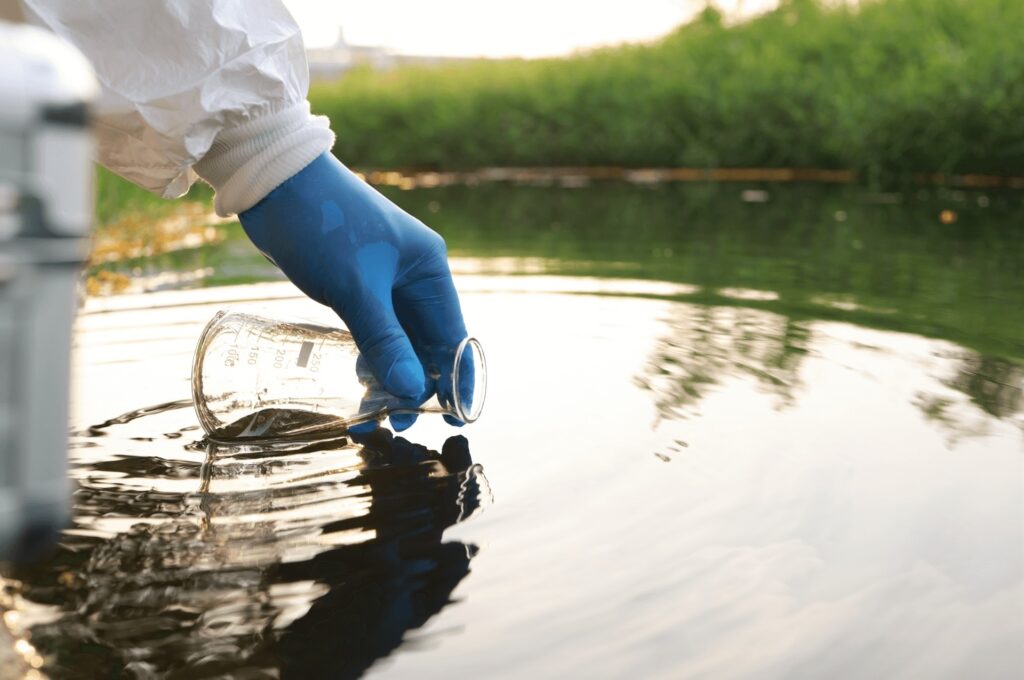
IC Inspiration
Turns out that DNA in the air can predict events that may have a major impact on society.
Imagine if farmers could know in advance of the danger from invasive fungi or pests, and then prepare to mitigate the risk for crops.
What if we could detect the event of another pandemic before it becomes widespread?
After all, If we could personalize medical treatment to match a specific person’s DNA, then is that so far-fetched?
What may sound like a fantasy Hollywood film may soon become a reality.
It is researchers Like Dr. Chooneea, who are determined to capture bio material out of thin air, which takes molecular biology research to new frontiers. If Darwin’s work first created awareness of biodiversity, it is eDNA sequencing and research that continues this line of work on a whole new level.
Changing the way we study nature to conserve it and leverage biotechnology is the goal of the Darwin Tree of Life project. It is only one of several initiatives to sequence all life on Earth.
New technologies for DNA capturing and sequencing are giving rise to more refined technology. What took days 30 years ago, now takes only hours. Innovative computation and AI-driven tools can help us gain a deeper understanding of the natural world.
This research lies at the base of new biotechnology developments that will help preserve the earth and enhance sustainability and human well-being.
The depth of this scientific research, the innovative tools that enable it, and the groundbreaking products and services it can lead to are truly motivational, and awe-inspiring.
Ofra Kleinberger-Riedrich is an informative content specialist and result oriented content marketer with 15+ years experience in B2B marketing.

You may like
Motivational
3D Printed Organs Save Woman’s Life and Accidentally Pave Way for Biology-Powered Artificial Intelligence
Published
3 weeks agoon
8 April 2024
A Great Advancement for 3D Printed Organs
3D printing in hospitals is nothing new, but for the first time in history, a woman received a 3D printed windpipe that became a fully functional without the need for immunosuppressants.
Immunosuppressants are used during organ transplants to keep the body from attacking the organ that it see’s as foreign. This means that the organ the woman received was organic and personalized for her, as if she had it her entire life.
This mind-blowing news shows that we are now closer than ever to being able to create full-scale, functional, and complicated 3D printed organs like a heart or lung.
But what about creating a brain?
3D Printing and Organoid Intelligence
Organoid Intelligence, or OI, is an emerging field of study that is focused on creating bio-computers by merging AI with real brain cells called organoids. Organoids are miniature and simplified versions of organs grown in a lab dish. They mimic some of the functions of fully grown organs, like brains. The idea behind OI is that by increase the cells organoids contain, they may begin to function like fully grown brains, and can then be used alongside computers to enhance Artificial Intelligence.
It turns out that the world’s first 3D printed windpipe was so successful that we are now closer than ever to creating the world first organoid intelligent bio-computer.
Here’s why.
The World’s First 3D Printed Windpipe
Transplant patients usually have to take a long course of immunosuppressants that help the body accept the organ. The body see’s the organ as foreign, and so the immune system begins to attack the new organ, which can lead to more complicated health problems.
The woman in her 50’s who received the 3D printed windpipe did so without any immunosuppressants. In just 6 months after the operation, the windpipe healed and began to form blood vessels, and of course, more cells.
The current goal of scientists in the field of Organoid Intelligence is to increase organoids from 100,000 cells to 10 million, and this begs the question:
Can 3D printing help build bio-computers by creating better organoids?
Can 3D Printing Help Build Bio-Computers?
The worlds first 3D printed windpipe shows that advances in 3D printing can create better functioning organs, and this implies that we can also create more intricate organoids to help in the field of Organoid Intelligence and eventually create bio-computers.
Its important to understand the distinction between 3D printing an organ and printing something like a tool or musical instrument.
The difference between printing an organ and printing a non-biological structure depends on the ink being used in the 3D printer.
3D printing non-organic structures will require ink that can be made from plastic, plastic alternatives like PLA, metal, and ceramics. On the other hand, 3D printed organs are made from ink called “bio-inks” that are a mixture of living cells and biocompatible substances like the ones mentioned above.
In the case of the 3D printed windpipe, the ink used was partly formed from the stem and cartilage cells collected from the woman’s own nose and ear. It was because of this bio-ink that the woman’s body did not reject the organ.
The Problem With 3D Printed Organs
Organs created with bioprinting need to function like real organs for the body to safely use them, and this does not happen right away.
The 3D printed organs need to go beyond just a printed structure and become living. They need to form tissues and cells that help create biological functionality, and forming these cells take time.
The problem with 3D bioprinting is that the ink used for the printer needs to be effective at doing this, and if it is not, the organ may not stay functional.
The ink used for the 3D-printed windpipe was made from part bio-ink and part polycaprolactone (PCL), a synthetic polyester material.
PCL is a used in the 3D ink for the purposes of maintain the structure of the windpipe, while the bio-ink is used to help the 3D printed organ to become fully biological in time so that the body can use it.
The PCL maintains the structure while the bio-ink does it’s thing.
The problem with PCL is that it is biodegradable and won’t last forever. In fact, doctors don’t expect the 3D-printed windpipe to last more than five years.
The Solution is Better Bio-ink
The 3D printed windpipe was not just made using PCL, but it contained bio-ink made from living cells too. The hope is that the living cells in the 3D printed organ—which came from the bio-ink—will assist the patient’s body in creating a fully functional windpipe to replace the PCL’s function.
If the organ begins to form cells and tissue by itself, then the function of PCL will be replaced by the biological function of the organ that is growing.
The organ becomes real!
Bio-Ink helps the 3D printed organ mimic it’s natural environment of cells and eventually become a real organ.
3D Printing Organs Will Save Lives
Every year, thousands of people need a lifesaving organ transplant. These transplants cost hundreds of thousand of dollars, and many people who need them don’t make it passed the waiting list.
3D Printing organs could give people the incredible opportunity to receive the help they need when they need it, saving thousands of lives annually, and millions of lives in the long run.
As advances are made in 3D Bioprinting, they will also be made in areas of Organoid and Artificial Intelligence, which shows that the progress being made in one place will once again shine its way to another.
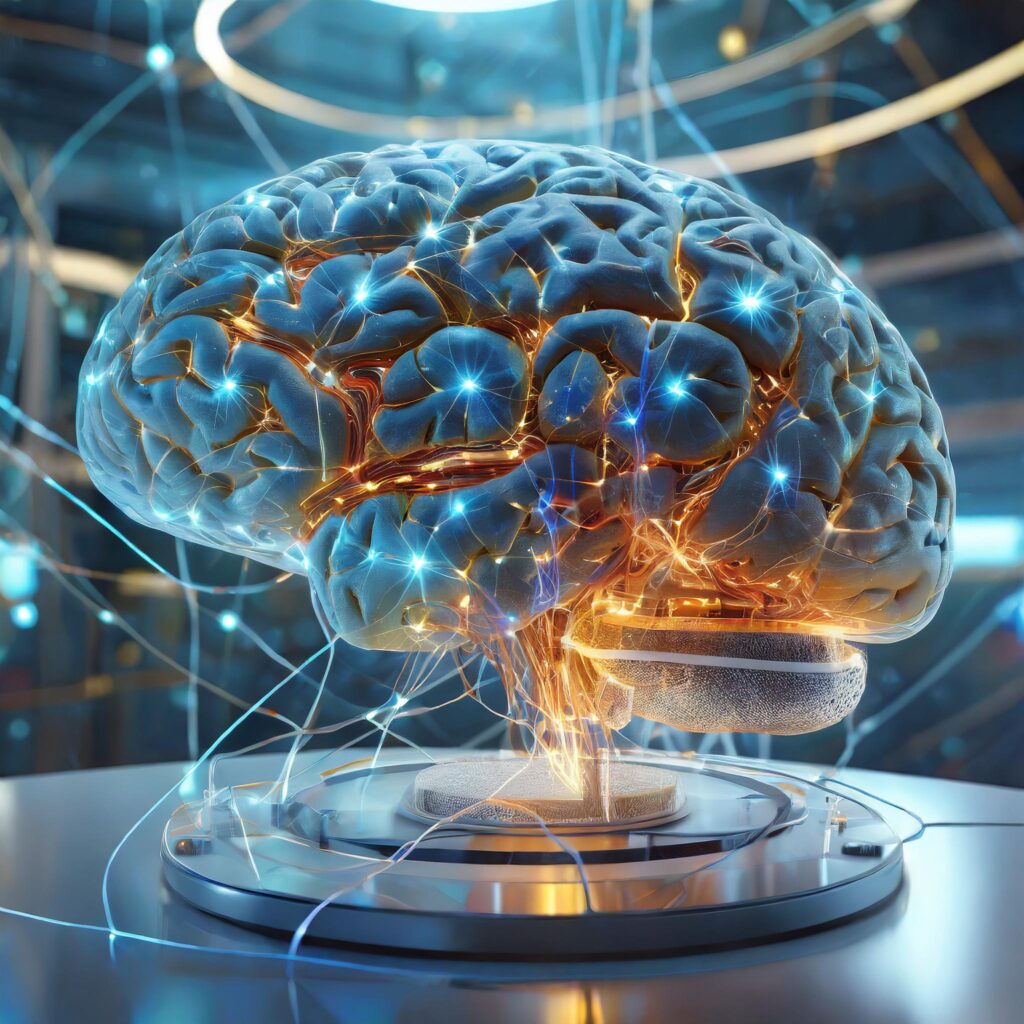
IC Inspiration:
If we can create better forms of bio-ink and produce fully functional organs using 3D printing, we will fundamentally change the entire health care system.
17 people die every single day waiting for an organ transplant, many of whom can’t afford the transplant in the first place.
The biggest hope in the world for everyone that is affected by this is that organs can be produced when they are needed, ending the transplant shortage and saving the incredible lives of millions of people in the future.
We have seen from this story that personalized organs made from a patients own cells can stop the bodies rejection of organs. This shows us that there will come a time when there will be no need for immunosuppressants therapy.
Even more amazing is that doctors use 3D printing to practice performing a surgery so that they can sharpen their skills before the surgery. This also helps them find better pathways for performing the surgery.
Think about it… If you can’t use a real organ to practice on, then 3D organs are the next best thing.
The production of organs, the irrelevancy of immunosuppressants, and more efficient surgery will eventually drive down the prices of transplants, and 3D printing organs in the future will not only save lives, but it will also increase the quality of those lives afterwards.
That is the sort of world we can create. It’s amazing to think of all the good that is being done right here, right now.
Science
Sora AI is Every Content Creators Dream. Its Almost Here!
Published
1 month agoon
29 March 2024Table of Contents
OpenAI’s Sora
Sora is the Japanese word for sky, our blue expanse that is often associated with limitless dreams and possibilities.
You may have heard that OpenAI is also releasing an AI video generator called Sora AI. With It’s fantastical visuals and life-like video, it’s without a doubt the top 5 AI technologies in 2024.
OpenAI recently launched Sora’s first short video, “Air Head”, and if it proves anything, its that Sora is every content creator’s dream turned reality.
But if you’re not convinced, perhaps this video might help. Here’s a little game called, “can you spot the AI video”?
How Can Sora AI Help Content Creators?
Video producers, film makers, animator, visual artists, and game developers all have one thing in common: They are always looking for the next big thing in creative expression. Sora AI is a tool that can greatly enhance the ability content creators have to fuel their imagination and connect with their audiences.
A misconception is that AI is going to replace human artists, videographers, and animators. But if Sora’s first short film has shown anything, its that a team was still needed to create the story, narrate the scenes, and edit the videos to create the final production.
Sora won’t replace artists; it will equip them with tools to express their artistry in different ways.
Sora’s First Short Film
Auteur and Toronto-based multimedia company, Shy Kids, was granted early access to Sora AI. Shy Kids is among the few granted early access to the AI video generator for the sake of testing and refining it before launch. The video the artists generated using Sora AI is called “Air Head”.
Pretty mind-blowing to think that one day, we might be able to create an entire movie with the main character as a balloon. Think of the comedies we can create.
How Does Sora AI Work?
Sora’s first short film “Air Head” shows that Sora AI is the most advanced AI-powered video generator tool in history. Sora creates realistic and detailed 60-second videos of any topic, realistic or fantasy. It only needs a prompt from the user to build on existing information and develop whole new worlds.
What We Know So Far
Sora AI is a new technology with limited access. There’s a strategic reason to limit information of a new technology, and it’s to manage the publics expectations while polishing the final product. Sora is a very powerful tool. It might be necessary to have strong safeguards and build guidelines before releasing it. Here’s what we know so far.
Sora Release Date
OpenAI has not provided any specific release date for public availability or even a waiting list. However, many sources indicate that it may be released in the second half of 2024. Currently, Sora AI is only being made available to testers called “red teamers”, and a select group of designers—like Shy Kids— have been granted access.
Sora Price
Open AI has not yet released a price for Sora AI and has made no comment on whether there will be a free version like its other AI models. Based on other AI text-to-video generators, its likely that there won’t be a free version, and that Sora will offer a tiered subscription model that caters to users who want to dish out videos regularly.
There is also a possibility of a credit-based system, similar to its competitor RunwayML. A credit-based system is where users purchase credits, and each credit is used for a specific task related to generating a video.
Sora’s Video Length
OpenAI has said Sora can generate videos of up to a minute long with visual consistency. Scientific America states that users will be able to increase the length of the video by adding additional clips to a sequence. Sora’s first short film “Air Head” ran for a minute and twenty seconds, which indicates that Sora’s video length can be anywhere between 60-90 seconds.
Sora’s Video Generation Time
OpenAI has not revealed how long it will take Sora AI to generate a video; however, Sora will use NVIDIA H100 AI GPUs. These are GPUs designed to handle complex artificial intelligence tasks. According to estimates provided by Factorial Funds, these GPUs will allow Open AI’s Sora to create a one minute video in approximately twelve minutes.
How is Sora AI Different from Other Video Generators?
Many text-to-video generators have trouble maintaining visual coherency. They will often add visuals that are completely different for one another for each scene. This requires the videos to be further edited. In some cases, it takes longer to create the video you want by using AI than it does by creating it yourself.
Sora AI seems to surpass other text-to-video generators in the level of detail and realism it creates. It has a deeper understanding of how the physical world operates.
It Brings Motion to Pictures
Another feature that Sora AI has is its still-life photo prompts. Sora will be able to take a still-life photo, such as a portrait, and bring it to life by adding realistic movement and expression to the subject. This means that you can generate images using OpenAI’s DALL. E model, and then prompt it with the desired text of what you would like the image to do.
This is like something out of Harry Potter. One of the biggest worries is that Sora AI will be able to depict someone saying or doing something they never did. I don’t think the world’s ready for another Elon Musk Deepfake.
Will Sora AI Undermine Our Trust In Videos?
There are over 700 AI-managed fake news sites across the world. OpenAI is already working with red teamers—experts in areas of false content—to help prevent the use of Sora AI in a way that can undermine our trust in videos.
Detection classifiers will play a big role in the future of AI. Among these detection classifiers are tools that can detect AI in writing, and content credentials that show whether an image was made using AI within the contents metadata.
AI image generators like Adobe Firefly are already using content credentials for their images.
Why do Sora AI Videos Look So Good?
Sora AI generates it’s videos using ‘spacetime patches’. Spacetime patches are small segments of video that allow Sora to analyze complex visual information by capturing both appearance and movement in an effective way. This creates a more realistic and dynamic video, as opposed to other AI video generators that have fixed-size inputs and outputs.
One comment said Sora AI videos are like dreams, only clearer… That’s not a bad way to put it. Afterall, dreams are like movies our brains create, and anyone who increases their REM sleep will understand. But speaking of movies, how will Sora AI affect Hollywood?
Can Sora AI Replace Movies?
As amazing as OpenAI’s text-to-video generator is, it can’t replace actors and use them in a prolonged storyline, but it can help producers create some fantastic movies. Sora AI can be used to create pre-visuals, concept art, and help producers scout potential locations.
Pre-visualization: Sora can turn scripts into visual concepts to help both directors and actors plan complex shots.
Concept Art Creation: It can be used to generate unique characters and fantastical landscapes which can then be incorporated into the design of movies.
Location Scouting: Using the prompt description, Open AI’s Sora can expand on location options, and even create locations that are not physically realizable. An example would be a city protruding from a planet floating around in space (I sense the next Dune movie here).
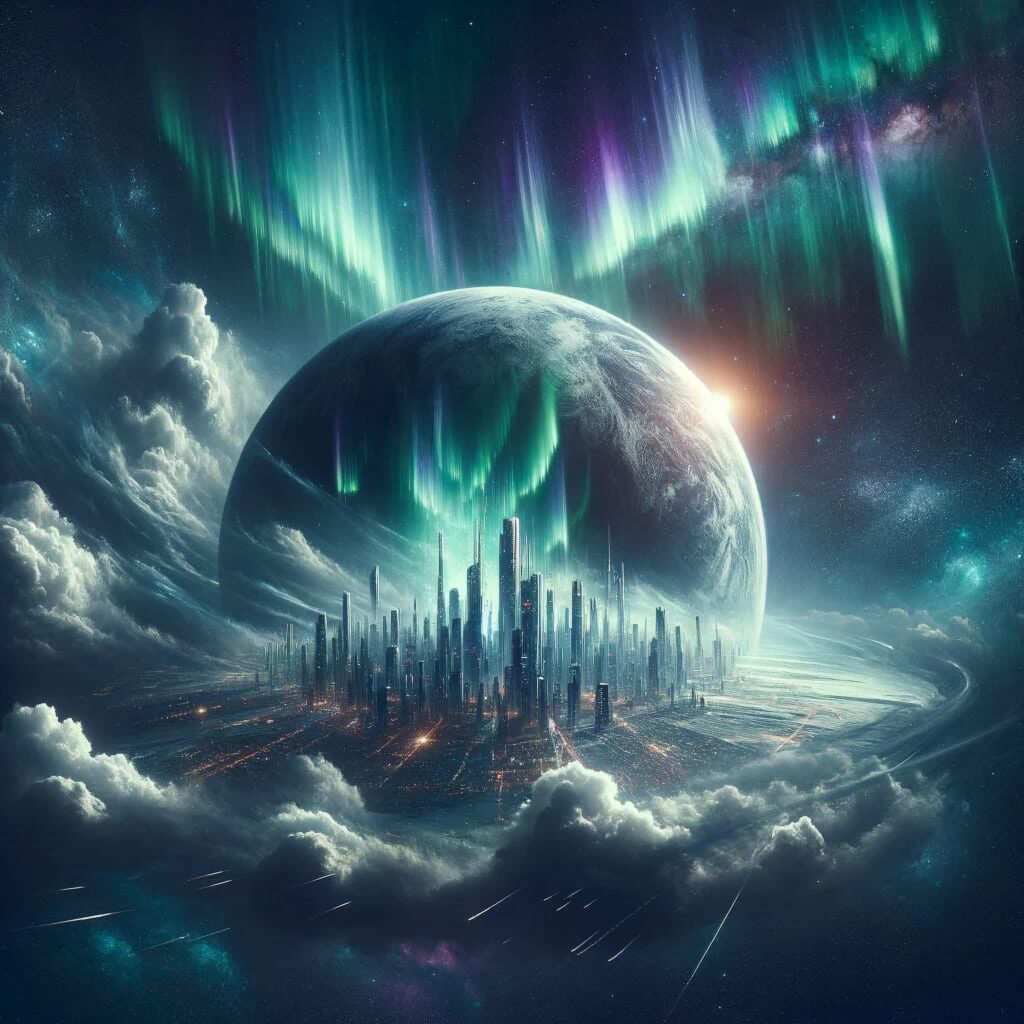
IC INSPIRATION
Content creators have a story to tell, and fantastic content is often the product of a fantastic mind. Sora could transform how we share inspiring stories.
Just imagine for a moment how long it took to conceptualize the locations and characters needed to create a movie like The Lord of the Rings. How many sketches, paintings and 3d models they had to create until they got their “aha moment”, and finally found the perfect look for the movie.
I wonder how much time Sora AI can save film and content creators, and with it, how much money. If it is truly as intuitive as its appearing to be, then it could revolutionize the work of filmmakers, video creators, game developers, and even marketers.
A lot of campaigns are too hard to visualize. Take Colossal Biosciences as an example. They are a company that has created a de-extinction project to bring back the Woolly Mammoth. How on earth do you conceptualize the process of de-extinction in a campaign video without spending an enormous amount of money?
Sora could be just what the doctor ordered.
Science
Colossal Biosciences: The Ultimate Science of De-extinction
Published
1 month agoon
24 March 2024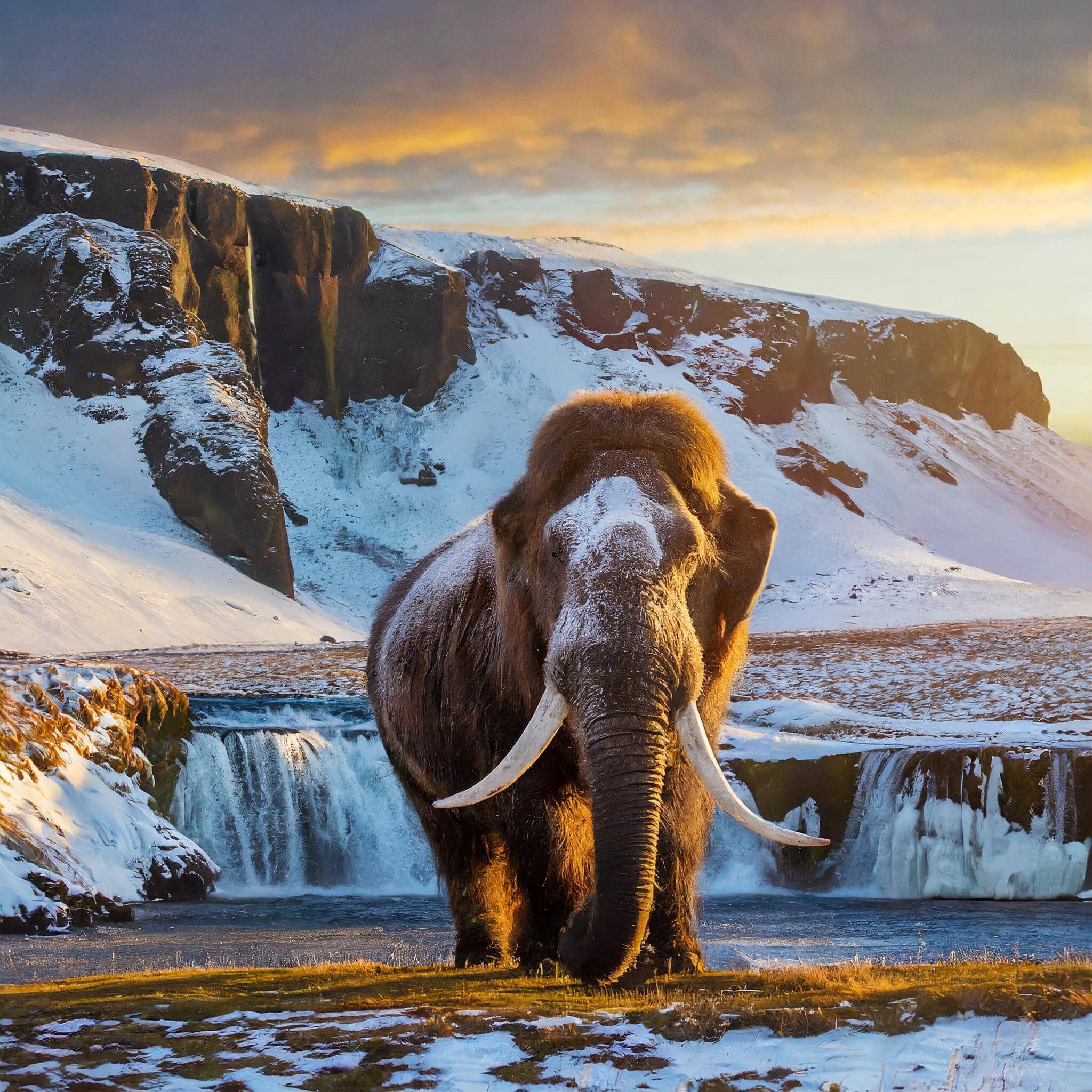
Table of Contents
The Extinction Problem
The diversity of the species on this planet is standing at a history-breaking climax that has never been equaled. More species are disappearing than ever before in recorded history. In the last 500 years alone, 869 species have been driven to extinction by human beings. Right now, as many as 16,928 species of plants and animals are known to be threatened with extinction.
The De-extinction Solution
Yet, at the same time, thanks to recent scientific advances in genetic engineering, we might be able to bring back once extinct species.
One company, Colossal Biosciences is doing just that with what can be called a potential “de-extinction solution”. They say they are getting closer to bringing back the dodo Bird, the Thylacine, and even the Woolly Mammoth.
These were a keystone species, and Colossal Biosciences says that using genetic engineering to bring them back could restore entire ecosystems.
What is Colossal Biosciences?
Colossal Biosciences is a biotechnology and genetic engineering company that is focused on de-extinction projects to bring back extinct species. Many extinct species have had a beneficial impact on ecosystems. Colossal claims that bringing them back could greatly help the Earth by curbing extinction and helping strengthen ecosystems.
According to their website, “Through technological and engineering breakthroughs in biosciences and genetics, Colossal is accepting humanity’s duty to restore Earth to a healthier state, while also solving for the future economies and biological necessities of the human condition.”
According to Business Wire, Colossal Biosciences has raised $225 million in funding to put towards their efforts.
Who Founded Colossal Biosciences
Colossal Biosciences was founded by Scientist Dr. George Church and entrepreneur Ben Lamm.
Dr. George Church is a leading scientist in synthetic biology at Harvard University. He is best known for developing the first genomic sequencing method and helping initiate the Human Genome Project—an undertaking to study and map human DNA.
Ben Lamm is a dynamic entrepreneur who has served as CEO of multiple companies that focused on everything from AI in space to marketing and video games.
When Was Colossal Biosciences Founded?
Colossal Biosciences officially opened its doors in 2021 after Dr. George Church and Ben Lamm started discussing the possibility of a de-extinction project.
Two years prior, Dr. Church and Ben Lamm got together for the first time. At that time, Lamm had been the CEO of another company he had founded called Hypergiant. This company’s focus was on aerospace and the military. As part of his work there, he’d been working on a small device that develops algae that can clean as much air as an acre of trees.
It was during this conversation that Dr. Church and Ben started discussing a colossal undertaking.
Where is Colossal Biosciences Located?
Colossal Biosciences has four main locations: Melbourne, Boston, Massachusetts, and Dallas. The company has a lab in Harvard University and another across the globe at the University of Melbourne in Australia.
The Colossal De-extinction Project
De-extinction is a process of creating a hybrid animal using genes from an animal that is similar to the extinct one. The traits these animals display are similar to the extinct species, and are specifically selected by scientists.
In other words, a de-extinct animal will be neither the living species nor the lost one. It will be a scientifically designed combination of the two.
This is a pretty startling thing to think about. It could be incredible to see something like a Woolly Mammoth walking around.
However, Colossal Biosciences has a much more profound reason for their huge undertaking.
Why De-Extinction?
Colossal Biosciences is using de-extinction to fill gaps in ecosystems long vacated by lost species to heal the world.
Every species plays a distinct role in its ecosystem. The natural world is very intertwined in a never-ending series of food chains and cycles. Everything impacts everything else.
When a species is removed from its environment, the impact can be very profound. So much so that people are creating shoes that help play the role that many of these important species fill—like the rewilding shoes.
Plants and animals that relied on the lost species can experience many problems. Overpopulation, a decrease in numbers, or even extinction can result from the loss. The quality of soil, air, and water can be impacted and even downgraded.
Colossal Biosciences believes they can reverse the damage. All they have to do is reintroduce these lost creatures to the ecosystems they left behind. The right animals can restart processes and habits long neglected. Habitats can be returned to an earlier and healthier state, and entire ecosystems formed.
The Process of De-extinction
De-extinction has made some real progress, but some challenges still remain. This makes de-extinction mostly conceptual. Regardless, the process of de-extinction is something that can be broken down into steps.
- Finding Well-Preserved Specimens of the Extinct Animal: The longer a species has been dead, the more degraded its DNA. Frozen tundra and museum samples are often the best sources of DNA for many animals.
- Sequence the Genes from the Extinct Species: Scientists use gene sequencing to compare the DNA of an extinct species to its closest living relative. This identifies the key differences that need to be altered to potentially bring the extinct animal back.
- Find the Closest Living Relative and Sequence its Genes: The genes of the lost animals are then combined with those of a living species to create offspring.
- Gene Editing: Once both sets of DNA have been sequenced, they must be combined or edited. Scientists will take the traits they need from the extinct species and insert them into the DNA of the living species. They will handpick the traits they need in order for the species to help regenerate the ecosystem.
- Create the Embryos: In the case of a mammal, the nucleus containing the DNA will be inserted into the egg, or ova. The egg will then be united with a sperm and implanted into the surrogate mother’s womb. For the bird, edited DNA will be injected directly into the surrogate mother so it can be transferred into the eggs that she lays.
- Birth or Hatching: The surrogate mother will be cared for until the baby is born, or the egg is laid and hatched. What emerges will be an animal that looks and behaves like its ancestors, but which is actually a combination of the extinct and the living species. It will contain all the traits necessary to replenish the earth.
The animals selected for De-extinction by Colossal Biosciences are the Woolly Mammoth, the Thylacine, and the Dodo Bird.
Colossal Woolly Mammoth
| Height | 6 to 12 Feet |
| Weight | Up to 6 tons |
| Extinction Date | Approximately 4000 years ago |
| Appearance | Resembles elephant with smaller ears. Two layers of fur, humpback, long truck, and stocky build. |
There are a few good reasons that Colossal Biosciences has chosen the Woolly Mammoth as one of its first projects.
Woolly Mammoths frozen in the Siberian tundra have often been so well-preserved that they almost looked like they were ready to get up and walk away. For this long gone species, surviving DNA is plentiful.
They also have a living relative that is already their exact clone. The Asian elephant’s DNA sequence is a 99.6% match to that of the Woolly Mammoth. That remaining 4% is still a pretty big hurdle for the scientists at Colossal Biosciences. However, the huge percentage still in place puts them way ahead of the game.
Why Bring Back the Woolly Mammoth?
The Woolly Mammoth lived in an ancient ecosystem called the Mammoth Steppe. Nearly 1600 billion metric tons of carbon are stored in the permafrost that comprises what’s left of the Steppe. Bringing back the Woolly Mammoth would bring back the Steppe, and this could help reduce global warming.
The Mammoth kept these ecosystems alive by trampling down bushes and pushing back trees. They also fertilized the grass with their droppings.
Colossal Biosciences lists 10 goals they expect will be achieved by bringing back the Woolly Mammoth.
· Slow down the melting of the permafrost.
· Prevent the escape of carbon trapped in the permafrost.
· Restore the lost grasslands of the Mammoth Steppe.
· Restore the Mammoth Steppe to its former, healthier condition.
· Return the Mammoth Steppe to an ecosystem to defend the Earth against climate change.
· Better understand the genetic traits of cold-resistant animals.
· Save modern elephants from extinction.
· Prove a link between genetics and climate change.
· Equip Nature to resist the damaging impact of human activity.
· Drive advancements in genetic editing.
Final Result: The Mammophant
The resulting hybrid creature is already being called a Mammophant. It will be part elephant, but it will also have the traits that made the mammoth the king of the frozen tundra. This will include the thick fur and extra layers of fat tissue.
It will also be big and powerful enough to carry on the work the mammoths left behind. This includes clearing the grasslands and, hopefully, returning them to their original healthy state. The grasslands, in turn, should provide a much-needed opportunity to manage the global warming problem.

Colossal Thylacine:
The Thylacine is an animal of many names. It has been known also as a Tasmanian Wolf or a Tasmanian Tiger, although it’s neither canine nor feline. It’s a marsupial that once lived on Tasmania, an Island off the Southern Coast of Australia.
| Height | 20” to 27” |
| Weight | 35 to 65 lbs. |
| Date of Extinction | 1936 |
| General Appearance | looks like a cross between a coyote and a tiger. Brown with stripes. Narrow, pointed face and long tail. |
How did the Thylacine Go Extinct?
Their story is a tragic one. Through exaggeration and wild tales, the Thylacine developed a reputation for being a fierce predator. It was mistakenly regarded as a huge threat to local sheep farmers on the Island. None of this was true. They mostly ate rodents, lizards, and birds.
The Islanders became determined to defend themselves against this falsely accused menace. At one time, the government even offered a bounty of one pound for each Thylacine killed. Farmers and hunters were more than happy to collect.
The last thylacine died in a zoo in 1936 having lived its last years in solitude and neglect.
Why Bring Back the Thylacine?
The Thylacine was an apex species. This means it was at the top of the food chain in its ecosystem. It played a key role in keeping the populations of other species balanced. When the thylacine went extinct, every animal beneath it on the food chain was impacted, which created a cascading effect called trophic downgrading. Scientists at Colossal Biosciences believe that a reintroduced the Thylacine can end trophic downgrading. Tropic downgrading causes a variety of negative consequence:
· Increased occurrences of devastating diseases.
· Increase in the number of wildfires.
· Decrease in the amount of carbon stored.
· Introduction of more potentially damaging invasive species.
· Interruption of the cycles which distribute chemicals and compounds throughout the ecosystem.
Of the three species being brought back first, the Thylacine is the one that’s been gone for the least amount of time. Plenty of embryos and young Thylacines were preserved before they disappeared. So, there’s plenty of intact DNA at hand.
The closest living relative to the Thylacine is a little mouse-like critter called the Fat-Tailed Dunnart. Its DNA is 95% identical to that of the Thylacine. This animal has a strong population and a conservation status of “least concern”. That means there are plenty of specimens and a large supply of living DNA for Colossal Biosciences to work with.
Final Result: The Thylanart
This hybrid doesn’t have an official name, yet. In the tradition of mixing parental names, it could be called a “Thylanart”. This animal, although it will be made from a creature the size of a mouse, will still grow to be as big as a small dog. It will also bear the traits that allowed its ancestor to be an apex animal and can rebalance the Tasmanian ecosystem to its former, natural state.
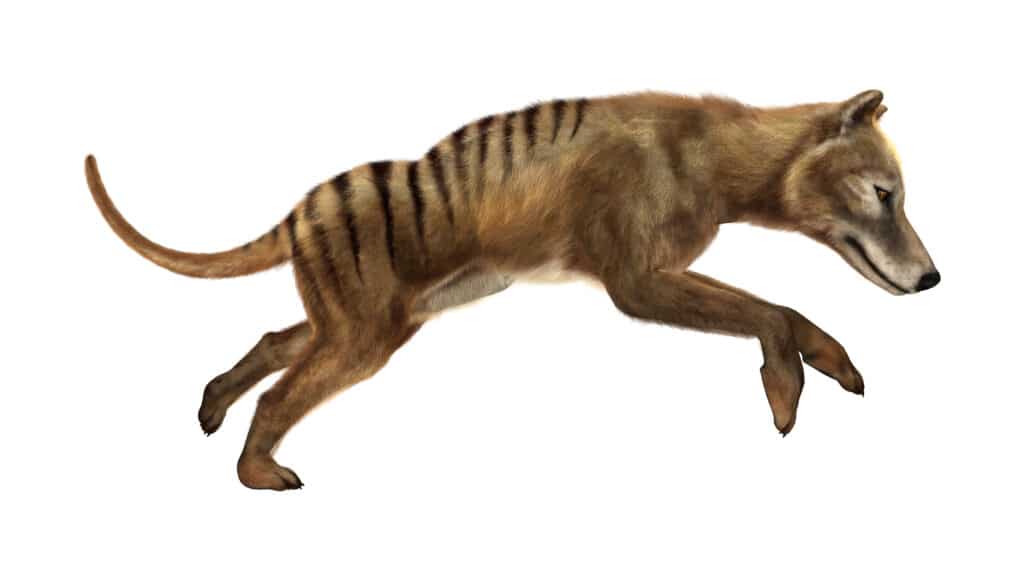
Colossal: Dodo Bird
The dodo, the only bird in Colossal Biosciences’ initial species index, is something of an iconic symbol for extinct species. It was a large, flightless bird that lived on tiny Mauritius Island which lies off the east coast of Madagascar, the famous Island of Africa.
| Height | 32” to 38” |
| Weight | 20 to 50 lbs. |
| Date of Extinction | Approximately 1662 – 1690 |
| Appearance | Thick, curved beak. Course, brownish-gray feathers, and feet. |
How did the Dodo Bird Go Extinct?
When humans started to colonize Mauritius Island in the 1500s, the dodo’s future changed forever. Settlers brought with them new species of animals such as rats, pigs, goats, deer, and birds. These creatures threatened the supply of naturally existing plant species, and they developed a taste for Dodo bird eggs. This is not good news for a bird that only lays eggs once a year.
One of the most devastating problems the dodo faced, however, came in the form of hunting rifles. Local settlers developed a liking for dodo bird meat and, fast as the dodo was, it couldn’t outrun a bullet.
Why Bring Back the Dodo Bird?
“Almost a third of Mauritius’ native fruits are no longer being dispersed as no animals are big enough to swallow their seeds.”
These startling words from the Natural History Museum’s website encompass the pressing need many scientists have to bring back the dodo bird. The loss of the dodo and other species is bringing this tropical ecosystem to its knees. Little by little, it’s disappearing simply because of the lack of a Dodo bird.
Final Result: The Docobar
This hybrid bird could be called a “Docobar” because of the mixture of dodo bird and Nicobar Pigeon DNA that it will have. The Nicobar pigeon, a brightly colored bird from India, is the Dodo bird’s closest living relative.
Colossal Biosciences aims to design the Hybrid to thrive on the dodo bird’s old stomping grounds, Mauritius Island. More than that, it should resume the activities of its ancestors such as swallowing and fertilizing seeds.
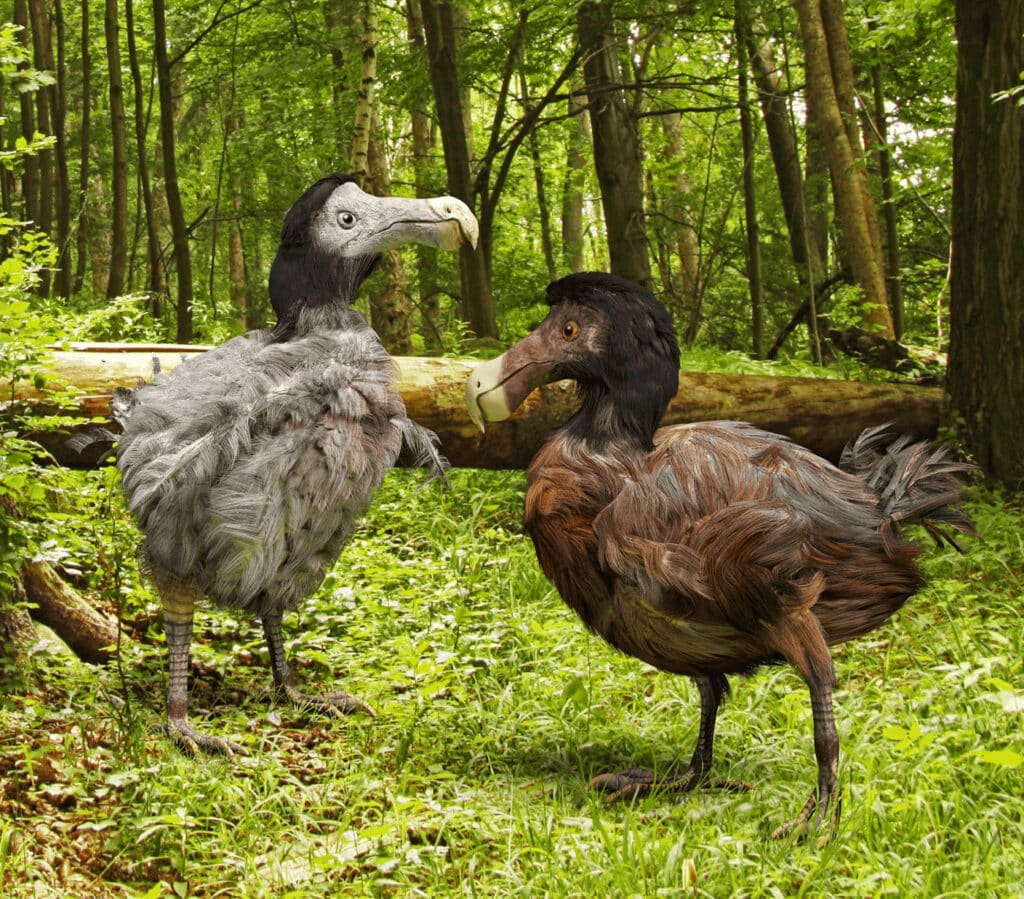
When Will the Animals Become De-extinct?
How long until the world can expect to see “Mammophants” thundering across the Arctic or to watch the first “Docobar” push its way out of its shell?
Of course, Colossal Biosciences can’t provide a precise birthdate for the world’s first resurrected hybrid animals. However, they’ve given their best estimates.
Woolly Mammoth – 2027-2028: Colossal is pushing hard for the Woolly Mammoth Hybrid to be the first revived. In early 2023, Colossal Biosciences raised an additional $60 million in funding specifically for this project.
Thylacine – 2028: Scientists believe the Hybrid Thylacine won’t be far behind the Woolly Mammoth. They’ve given it a projected birth date of as early as 2028. Marsupials have a much faster gestation rate than most other mammals. This could mean we see them sooner than the Mammoth.
Dodo Bird – Unknown: The dodo bird’s revival is very complicated and challenging due to a lower selection of viable DNA samples. As well, their closest living relative isn’t a closely related as scientists would like. Although new techniques are being developed, it’s not known when there might be a fertilized egg.
De-extinction is becoming a more popular topic of conversation, especially with Colossal Biosciences gaining popularity. It’s a new and strange idea once only possible in the realm of fantasy, and the world is still trying to make sense of it. It could be the miracle the environment needs, or it could be a big mistake.
The Pros of De-Extinction:
There are plenty of arguments as to why de-extinction could be a welcome new phase in our natural history.
- Knowledge: Continued work on the de-extinction project brings new knowledge of DNA and genetics. This new understanding could help us in ways we can’t imagine.
- Environmental Health: The resurrected animals could help us bring the planet back to a state of health not seen in a long time.
- Justice: Humans created the mess that the planet currently finds itself in. It’s only fair and right that humans figure out how to fix it.
- Curiosity: There’s just a certain awe that comes with the prospect of seeing a species never before seen alive.
The Cons of De-Extinction:
At the same time, there are lots of reasons for scientists to proceed with plenty of caution. Colossal biosciences will have to consider the following:
- Animal Rights: The simple fact is, that animals can’t tell us if this is something they want or not. Injury or illness could be caused by inevitable trials and errors.
- Viruses: There is a risk that resurrected genes could also bring back viruses and diseases the world is not prepared for.
- Environmental Health: Scientists can’t be 100% sure how these hybrids will impact the ecosystems they inhabit.
- Political Focus: The introduction of de-extinct species could take attention and resources away from other issues. Current endangered species could be neglected.
The biggest question being asked, however, and the one that needs the most attention is the question of ethics.
The Ethical Debate About De-Extinction:
With all the talk of de-extinction, many people are reminded of a movie that came out in the 1990s. It involved de-extinct dinosaurs running around a tropical Island terrorizing scientists and children.
Over and over again, a thought from that movie has been resurfacing. In a nutshell, we know we can do it. The question is whether we should do it.
A big concern is that, if de-extinction became a reality, people might think there is now an infinite supply of any given species. They might become lax about conserving and protecting wildlife. Money that could be used to solve world hunger or clean up plastics pollution might, instead, go into the next hybrid animal.
Paul and Anne Erlich from the Yale School of the Environment argue in their publication that de-extinction projects— like the one Colossal Biosciences is undertaking—are a terrible idea. If scientists don’t first address problems like destructive mining practices or creating a clean energy future, questions of de-extinction won’t even matter.
The environments these extinct animals left behind have changed vastly while they’ve been away. It’s not even certain that they could survive in the world that exists today.
IC Inspiration
If one thing is certain it’s that there’s no stopping ideas, whether they’re good or bad.
As strange as it sounds, Colossal Bioscience says that they are not playing God. They argue that de-extinction is not only a good idea, but a duty.
Dr. Andrew Pask is a professor of bioscience at Melbourne University in Australia. He also works with Colossal Biosciences. In an interview with the Aljazeera website, Dr. Pask was reminded of de-extinction objectors who liken the idea to ‘playing god’.
“We played God when we exterminated these species,” he argued, “I think all of these efforts of de-extinction are about trying to play smart human, to try to undo when we played God and get the world balanced back again.”
One major effort to play ‘smart human’ came in 2016. The International Union for the Conservation of Nature released a new and unique document titled: Guiding Principles on Creating Proxies of Extinct Species for Conservation Benefit. The document represents the earliest effort at providing a map for this new road that lies ahead.
It provides insights on the ethical, moral, and safe way of handling any new hybrid species that may be developed in the future.
The good news is we’re at the very beginning of this journey. There’s still time to take it one step at a time and make sure we’re moving forward with knowledge, empathy, and goals that will benefit the entire planet.
Is this good idea? Let us know what you think about de-extinction in the comments below.

The Humane AI Pin is Here! So is Everything You Need to Know

3D Printing in Hospitals Has Saved Children’s Lives

Alef Model A Flying Car Pre-Orders Surge to a Whopping 2,850

New Atmospheric Water Generator Can Save Millions of Lives

Michelin Uptis: Airless Car Tires Emerging in 2024

3D Printed Organs Save Woman’s Life and Accidentally Pave Way for Biology-Powered Artificial Intelligence

Sora AI is Every Content Creators Dream. Its Almost Here!

Colossal Biosciences: The Ultimate Science of De-extinction

Top 5 Genius Plastic Alternatives to Help Save the Planet

A Talking Lamp? Top 5 Unbelievable AI Technologies in 2024
Trending
-
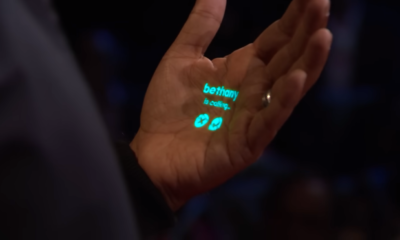
 Technology4 months ago
Technology4 months agoThe Humane AI Pin is Here! So is Everything You Need to Know
-

 Healthcare5 months ago
Healthcare5 months ago3D Printing in Hospitals Has Saved Children’s Lives
-
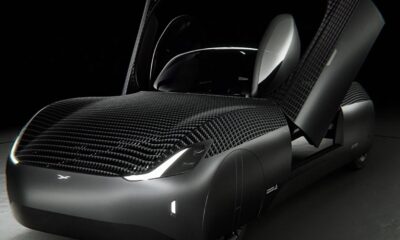
 Technology2 months ago
Technology2 months agoAlef Model A Flying Car Pre-Orders Surge to a Whopping 2,850
-

 Technology11 months ago
Technology11 months agoNew Atmospheric Water Generator Can Save Millions of Lives
-

 Technology5 months ago
Technology5 months agoMichelin Uptis: Airless Car Tires Emerging in 2024
-

 Sustainability10 months ago
Sustainability10 months agoTeamSeas Uses Gigantic Robot to Battle Plastic Pollution
-

 Sustainability2 months ago
Sustainability2 months agoArchangel Ancient Tree Archive: Cloning Ancient Trees to Build Strong Forests
-
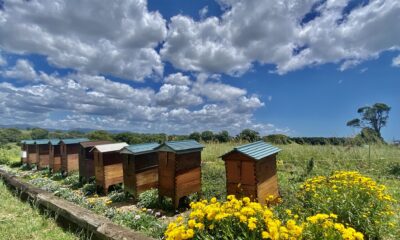
 Motivational3 months ago
Motivational3 months agoFather Son Bond Creates Buzz: The Flow Hive Success Story